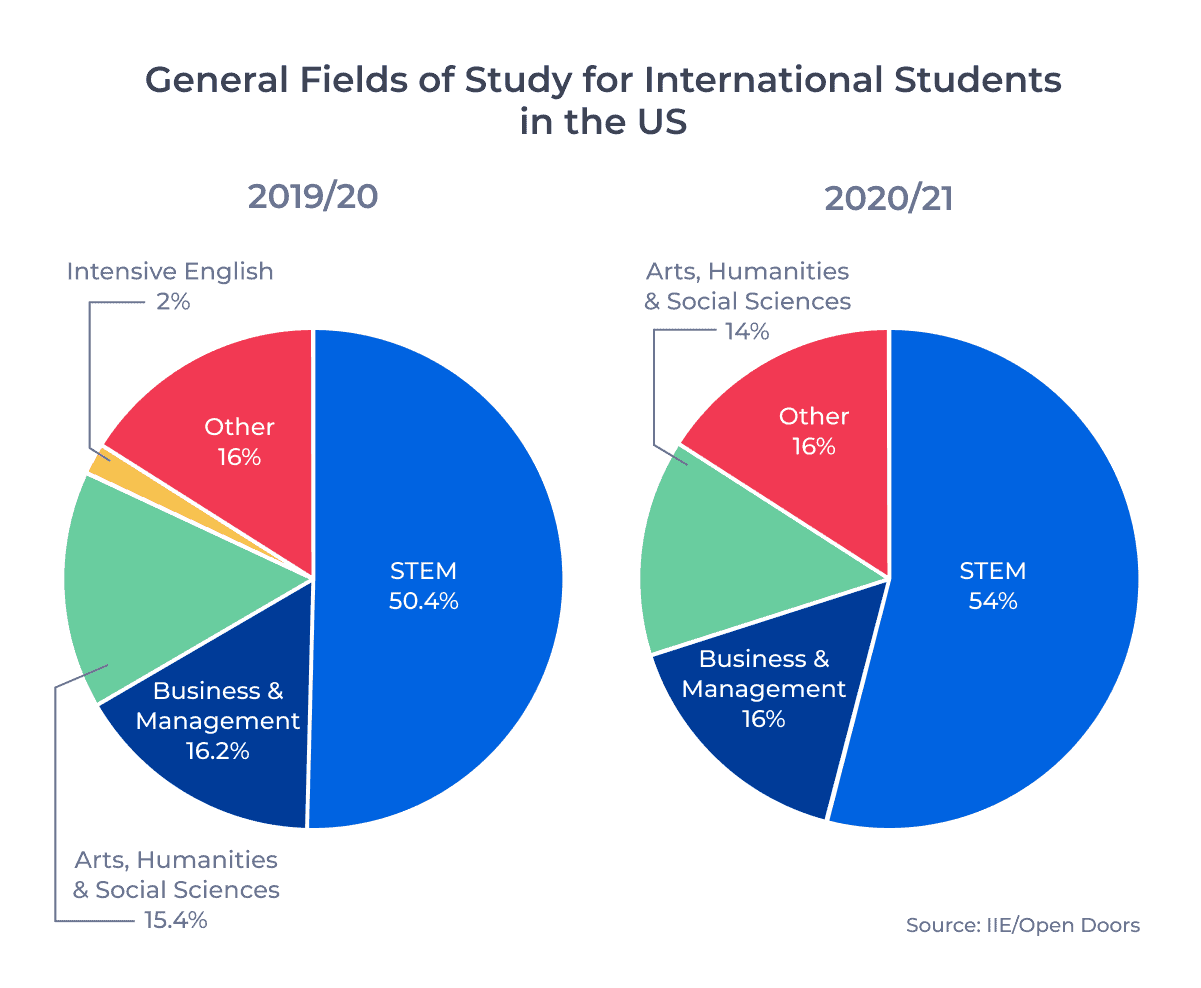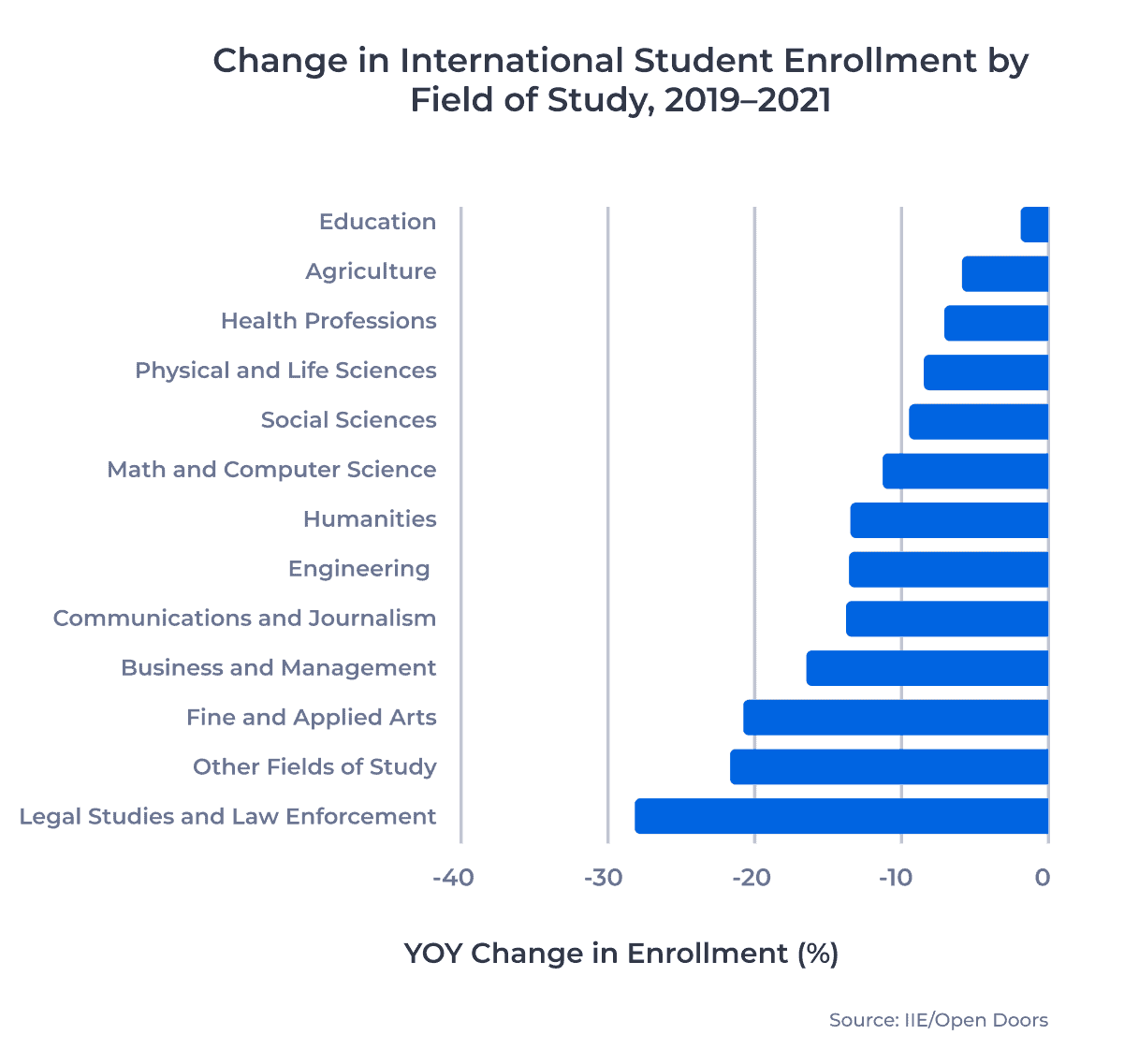The COVID-19 pandemic sent tremors throughout the world of higher education. For institutions based in the United States, the most popular study abroad destination in the world, the past 19 months have been particularly difficult to navigate.
While schools and students both endured significant struggles, there’s much for industry professionals to learn from looking back on 2021. The newly released 2021 Open Doors Report on International Education Exchange helps us to reflect on the events of the year.
Open Doors offers extensive coverage of student mobility trends, breaking down enrollment by study level, degree type, institution type, and more. Earlier this week, I discussed some of the top-line takeaways from the report. Today, I want to talk about field of study. Which fields experienced the smallest and largest declines? Which countries are pursuing the fields of study that resisted drops in enrollment? How will COVID-19 impact the future interests of international students studying in the US?
Key Insights at a Glance
- Since the 2014/15 academic year, enrollment in math and computer science programs has grown by over 82%.
- Enrollment in education programs fell by just 1.9% in 2020/21—well below the average decrease of 15.1%.
- A higher proportion of Bangladeshi students (80%) enrolled in STEM programs in the US in 2020/21 than any other nation.
- 61.5% Malaysian students were enrolled in STEM programs in 2020/21, up from 25.7% the previous year.
In this edition of ApplyInsights, I’m diving deep into the Open Doors field of study data to answer these questions. Let’s get started!
International Students in the US by General Field of Study
Enrollment numbers at US institutions fell across the board during the 2020/21 academic year—that’s not news. However, one of the trickle-down effects of the pandemic was its impact on applications within certain fields of study.
The following charts show the breakdown of the international student population in the US over the past two academic years:

The field of study distribution remained largely unchanged from 2019, with the only noticeable differences being the 4 percentage point increase in STEM programs and the dropoff in Intensive English Program (IEP) enrollment this year.
Intensive English program enrollment tumbled by 61% in the 2020/21 academic year—four times the decrease across all fields of study (15%).1 Only 8,355 international students enrolled in IEPs in the US last year, down from 21,301 the year before. This massive dip in enrollment is likely tied to the inability of students to study in-person. Peer interaction, local community engagement, and travelling are core elements of what make IEPs so popular.
The enrollment drop hit this sector hard—In 2020, two out of every three IEPs were forced to cut their program budget, lay off teachers, or combine multiple classroom levels in an effort to save money.
Figures should begin to rebound as US borders reopen, but I anticipate IEPs taking longer to fully recover than the post-secondary sector as scaling back to pre-pandemic levels from hiring and budgeting perspectives may be a challenge.
For more on the challenges facing the IEP sector and how the sector is evolving to meet them, check out my previous ApplyInsights articles.
Breaking Down Individual Field of Study Trends
While the distribution of international students across general field of study groupings largely held over the past two years, we get a much different picture by examining individual fields of study:

As we see from the chart above, the impact felt by the pandemic varied substantially between individual fields of study.
Resilient Fields of Study
Let’s take a look at the fields of study that showed the most stability over the past 9 months.
Education
You wouldn’t suspect we’re in the midst of a global pandemic by looking at international student enrollment rates in education programs, which fell by only 1.9% in the 2020/21 academic year. The surprising resiliency displayed within this field of study is likely due to the urgency shown by educational programs to implement hybrid learning at the onset of the pandemic.
Education programs were some of the first to implement successful and dynamic hybrid delivery methods in the US. This helped over 15,000 students to feel confident in the quality of the education they were receiving.
Education programs were more popular among Canadian students than any other nationality last year, as 5.1% of Canadians pursued a degree within this field of study.
Studying education in the US is a much more feasible option for Canadian students than anyone else. Their proficiency in English, familiarity with US culture, and presence in time zones that make sense for remote learning are all likely driving forces behind Canadian’s affinity for education.
Health Professions
Health professions also resisted a steep decline in enrollment last year, decreasing by 7.1%—less than half the average decline. The boom in demand for professional healthcare workers in the US over the past 19 months is likely driving this trend. COVID-19 has not only increased the need for healthcare professionals on the front lines, but also treatment for other areas of impact, such as mental health.
The following chart shows the country of origin breakdown of students who studied health professions in 2020/21:
Canadian, Chinese, Indian, and South Korean students were the driving force behind these stable enrollment numbers, as more than half of all health profession students came from one of these four countries.
Students from Pakistan, South Korea, and Canada displayed a significantly larger appetite to study health professions in the 2020/21 academic year, as 13.5%, 10.6%, and 14.9% of students from those respective countries pursued degrees in this field of study.
Pakistani students’ interest in health professions grew by the most this year, as their enrollment increased by 10 percentage points.
The demand for healthcare workers is a trend that we’re also seeing outside of the United States, with Canada projecting a vacancy of over 110,000 job openings in healthcare over the next four years.
The Status of STEM
Engineering sat just below the average national decline at 13.6%, while math and computer science enrollment fell by 11.3%.
These were the two fastest-growing fields of study over the last seven years, as Engineering grew in popularity by 12% since the 2014/15 academic year while math and computer science enrollment rose by 82% over the same period. Given this rapid pre-pandemic growth, I expect both of these to be the two fastest-growing fields of study in the US for the 2021/22 academic year.
These were the two most in-demand fields in 2020/21 and the number one choice of each of the top ten source countries.
Major Source Countries for STEM Students
The booming STEM job market, the field’s high earning potential, a long history of successful international STEM students, and the OPT post-graduate work extensions. These are all reasons why STEM programs are the most popular choice among international students in the US.
A larger share of international students pursued STEM degrees in 2020/21 than in any of the past seven academic years.
Chinese and Indian students lead the charge in STEM enrollment, but there are a handful of emerging markets that are also pursuing to STEM fields. Let’s take a look at the countries sending the largest proportion of STEM students to the US.

A higher proportion of Bangladeshi students enrolled in STEM degrees last year than any other top 25 source country, with 8 of 10 students from Bangladesh pursuing US higher education at the STEM level.
Engineering was the top choice among this group, with 42.5% studying in this field.

Coming in a notch below first place Bangladesh, 79.2% of Iranian students in the US in 2020/21 were enrolled or working in STEM. 49.2% of the total enrolled in engineering. Both rates ranked second-highest among the top 25.
Another outlier in the Iran data is seen in its proportion of graduate students—75%. This is by far the highest proportion of graduate students of any source country this year, coming in at 9 percentage points above the second-place country, Bangladesh.

Just over 76% of students from Nigeria studied STEM in 2020/21. Math and computer science were the top choices, with one in three Nigerian students enrolled in those fields.
7.1% of Nigerians pursued physical and life sciences last year, which ranked first among the top 25 source countries.

Perhaps the most interesting enrollment numbers can be found in Malaysian students, who pursued STEM fields at a 71% clip during the 2020/21 academic year—up from 53% the previous year.
61.5% of Malaysia’s 5,280 students in the US were enrolled in engineering degrees, tops among all nations in 2020/21. This represents a growth of nearly 36 percentage points from 2019/20. It was the highest single-year program enrollment increase of the past seven years.
Over 30% of Malaysian students in the US were enrolled in OPT, the third-largest proportion among all source countries, behind India and Taiwan.
Looking Forward
In 2020/21, there was a 4% year-over-year increase in total international students. As as the new year approaches and international applications continue to pour in, international enrollment in the US will rise further. But as we look back to the events that have led to this recovery, there’s a lot to learn.
Here are some of my recommendations for US institutions and recruitment partners trying to leverage the most recent Open Doors data:
- Math and Computer Science programs should look past an outlier of a down year, and look to recruit students from Nigeria, Bangladesh, and other emerging markets in an effort to revive pre-pandemic growth.
- As competition from other international post-graduate work programs, such as the GIR and PGWPP, intensifies, recruitment partners should highlight the benefits of the OPT program—particularly the extension it grants to STEM students.
Published: November 19, 2021
Subscribe to ApplyInsights
Sign up for the latest insights on international education.
 Meti Basiri
Meti Basiri
Co-Founder and Chief Marketing Officer (CMO)
Meti is driven by the belief that education is a right, not a privilege. He leads the International Recruitment, Partner Relations, and Marketing teams at ApplyBoard, working to make education accessible to people around the world. Meti has been instrumental in building partnerships with 1,500+ educational institutions across Canada, the United States, the United Kingdom, and Australia. Working with over 7,500 international recruitment partners, ApplyBoard has assisted more than 200,000 students in their study abroad journey. Follow Meti on LinkedIn for more access to ApplyInsights and key industry trends.
FOOTNOTES:
1. All data courtesy of the Institute of International Education (IIE). Please note that the IIE changed its definition of international student this year to include students studying remotely from their home country. Previous editions of the report included only student visa holders.



